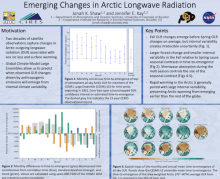Processes Controlling the Seasonally Varying Emergence of Forced Arctic Longwave Radiation Changes
Jonah
Shaw
CU Boulder/CIRES
Poster
Most observed patterns of recent Arctic surface warming and sea ice loss lie outside of unforced internal climate variability. In contrast, human influence on related changes in outgoing longwave radiation has not been assessed. Outgoing longwave radiation captures the flow of thermal energy from the surface through the atmosphere to space, making it an essential indicator of Arctic change. Furthermore, satellites have measured pan-Arctic radiation for two decades while surface temperature observations remain spatially and temporally sparse. Here, two climate model initial-condition large ensembles and satellite observations are used to investigate when and why twenty-first-century Arctic outgoing longwave radiation changes emerge from unforced internal climate variability. Observationally, outgoing longwave radiation changes from 2001 to 2021 are within the range of unforced internal variability for all months except October. The model-predicted timing of Arctic longwave radiation emergence varies throughout the year. Specifically, fall emergence occurs a decade earlier than spring emergence. These large emergence timing differences result from seasonally dependent sea ice loss and surface warming. The atmosphere and clouds then widen these seasonal differences by delaying emergence more in the spring and winter than in the fall. Finally, comparison of the two ensembles shows that more sea ice and a more transparent atmosphere during the melt season led to an earlier emergence of forced longwave radiation changes. Overall, these findings demonstrate that attributing changes in Arctic outgoing longwave radiation to human influence requires understanding the seasonality of both forced change and internal climate variability.

shaw-jonah-polar-poster.pdf
(9.18 MB)
